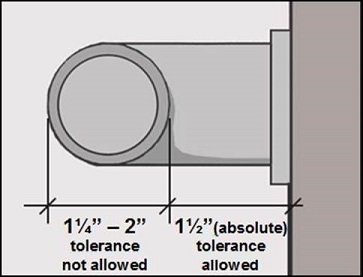Conventions [§104]
Most dimensions in the ADA Standards are specified as a minimum, maximum, or as a range. In a few areas, absolute dimensions are specified.
Construction and Manufacturing Tolerances
A tolerance is an unintended, but permitted (i.e., “tolerated”), variation from a specified dimension resulting from the process of construction or manufacture. The ADA Standards recognize conventional industry tolerances for dimensions not expressed as a range. This applies to field work, not design work. Tolerances necessary for a particular manufacturing process are also permitted. Information on specific tolerances may be available from industry and trade organizations, code groups and building officials, and published references.
Many dimensions in the ADA Standards are expressed as a range instead of an absolute so that designers can allow some room for minor deviations in construction or manufacturing. Tolerances do not apply to dimensions specified as a range.
Grab Bar Diameter and Clearance
Construction or manufacturing tolerances are permitted for the required clearance at grab bars since this is an absolute dimension (1½ inch), but they are not permitted for the grab bar diameter because a range is specified (1¼” to 2”).
Calculation of Percentages
Some provisions in the ADA Standards specify a minimum number of elements or spaces as a minimum percentage or proportion. Rounding up to the next greater whole number is required where fractions or remainders occur. For example, if the standards require access to at least 5% of an element and a total of 25 are provided, at least 2 must be accessible (rounding up from 1.25).
In the case of specifications for dimensions or sizes that involve percentages or ratios, rounding down for values less than one half is allowed.
Recommendation: Dimensions expressed as a range are intended to accommodate deviations in the field. It is good practice to specify accordingly. For example, for the location of wheelchair accessible water closets (16” – 18” centerline from side walls or partitions), specifying to the midpoint of the range (17”) will accommodate any construction variations up to 1” plus or minus. For dimensions not expressed as an absolute (“X maximum” or “Y minimum”), specify in a manner that accommodates the expected tolerance within the required dimensions by subtracting the tolerance from the required maximum or adding it to the required minimum.
Figures in the Standards
Figures in the ADA Standards are provided only for informational purposes to illustrate dimensions and requirements contained in the text. They do not establish enforceable requirements unless specifically stated otherwise.



User Comments/Questions
Add Comment/Question